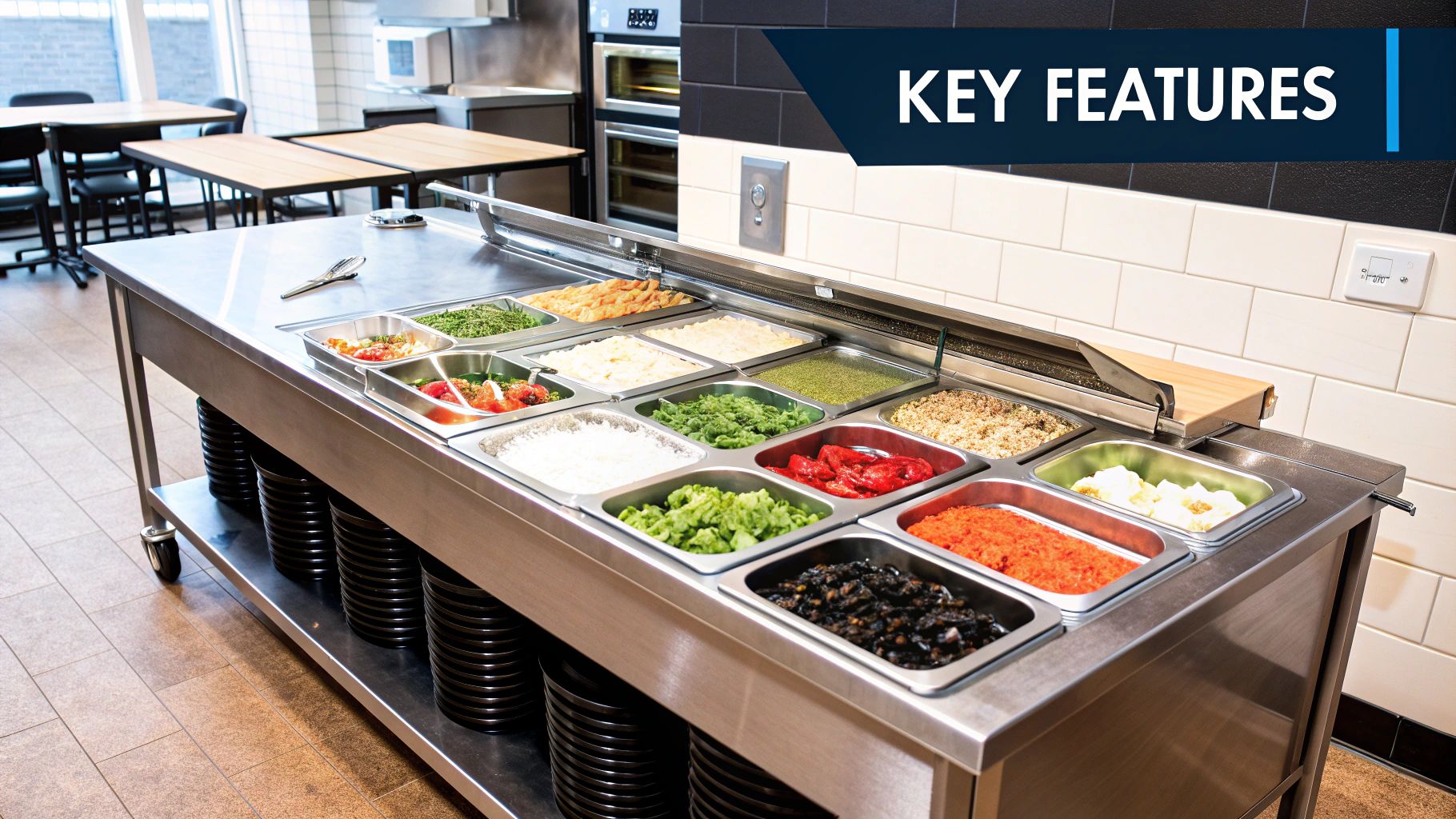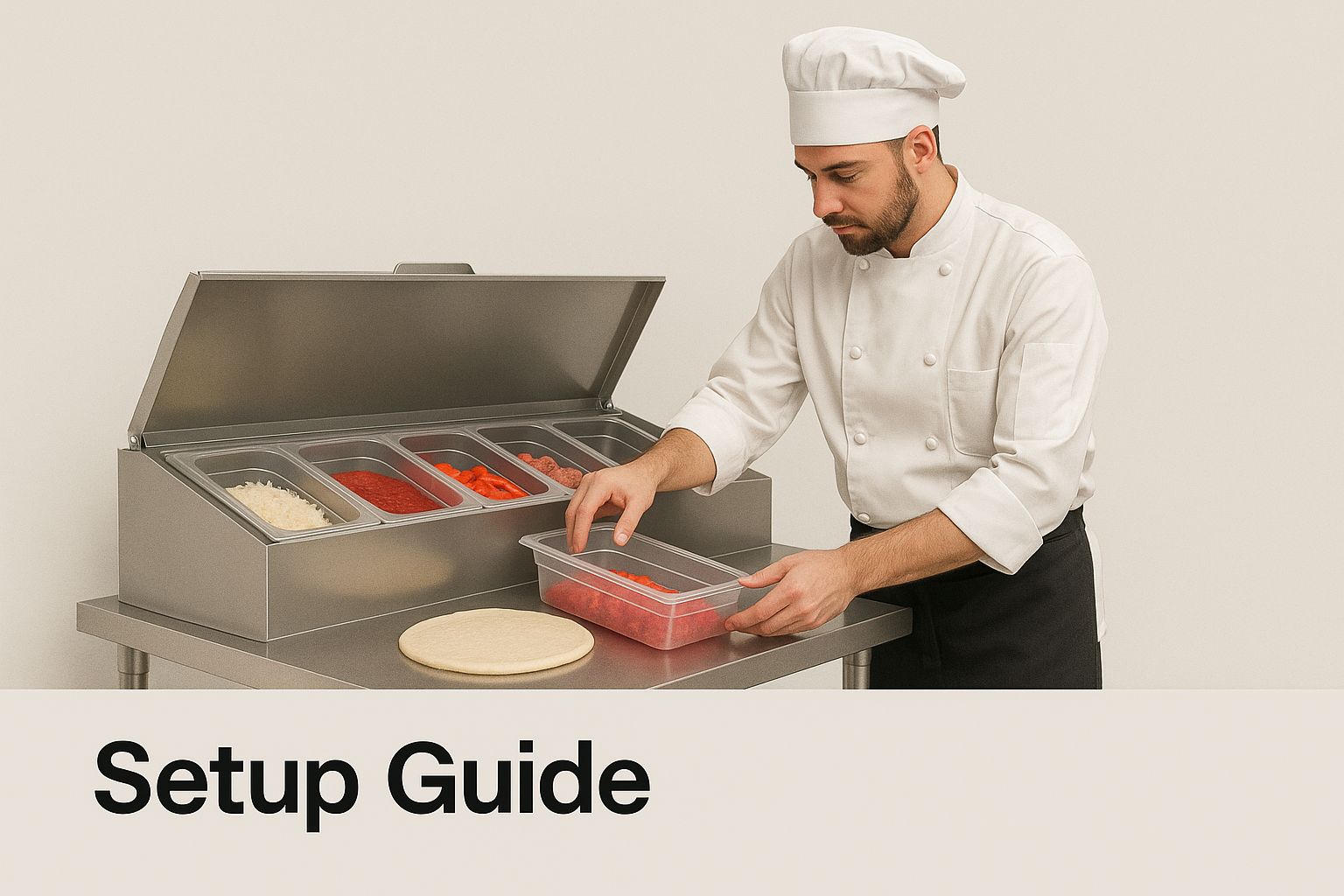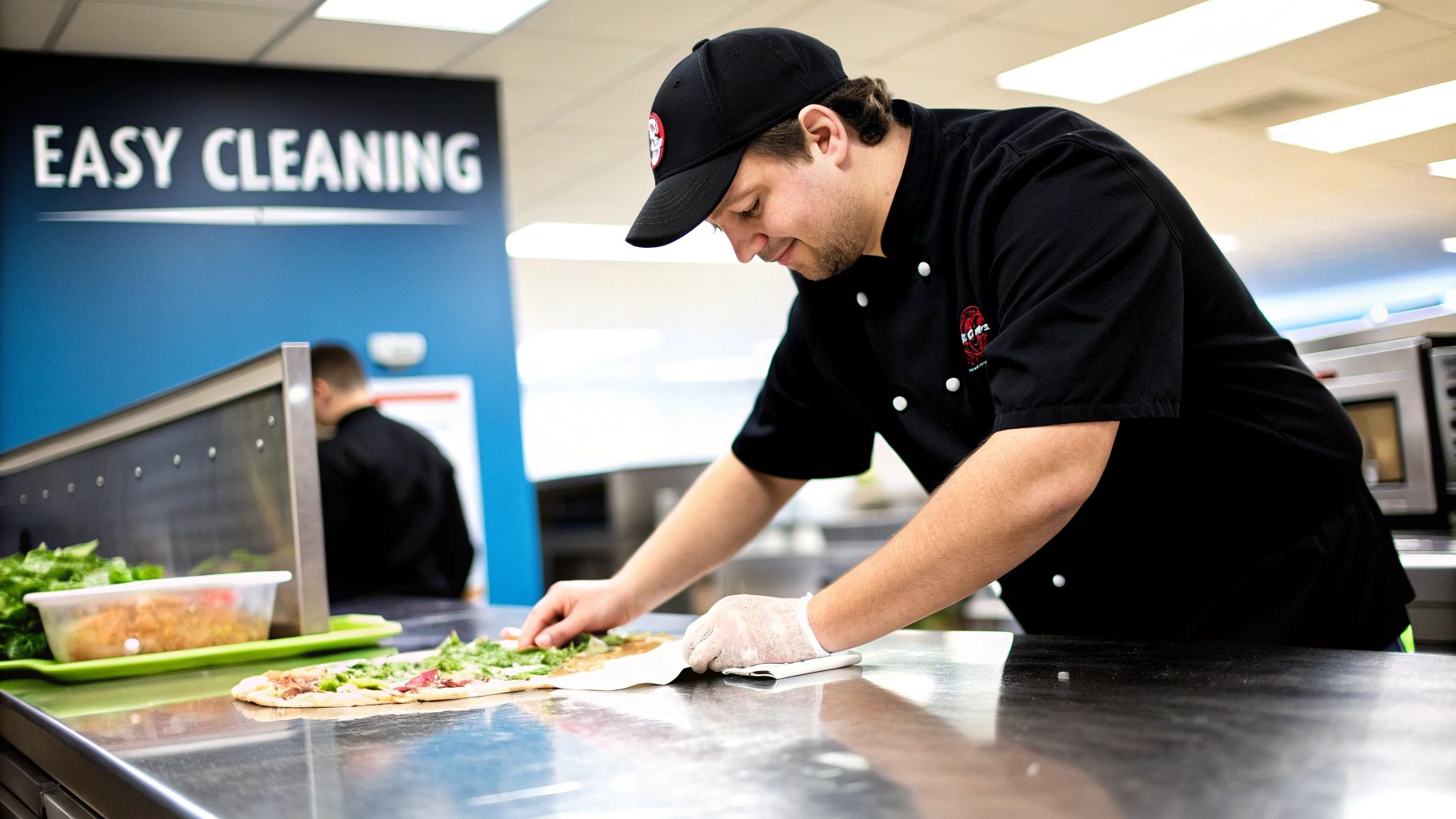
Choosing Your Atosa Pizza Prep Table
Share
An Atosa pizza prep table is more than just a fancy refrigerated cabinet; it's the command center of your entire pizza-making operation. Think of it as the essential hub where fresh, chilled ingredients meet efficient assembly, paving the way for smoother, faster service for any pizzeria trying to keep up with hungry customers.
The Heart of Your Pizzeria's Workflow

Picture your pizzeria during the Friday night rush. Orders are flying in, the kitchen is buzzing, and the pressure is on. More often than not, the biggest bottleneck is the pizza assembly line. The right prep table acts as the heart of this entire workflow, pumping efficiency through every step of the process. An Atosa pizza prep table is engineered specifically to solve this exact problem for pizza restaurants.
It’s the ultimate intersection of refrigeration and workspace. Down below, you have a spacious refrigerated cabinet that keeps dough, sauces, and extra cheese at perfectly safe temperatures. Up top, a refrigerated rail holds all your toppings—from pepperoni and mushrooms to onions and olives—chilled and right within arm’s reach. This seamless integration is what transforms a chaotic scramble for ingredients into a streamlined pizza-making dance.
Why It’s More Than Just a Table
A well-designed prep station directly impacts your pizzeria’s success in some critical ways. When every single ingredient has its designated, chilled spot, your team can build pizzas much faster. That means shorter ticket times and happier, less-hangry customers. This organization also ensures that every pizza gets a consistent amount of cheese and toppings, which is absolutely crucial for cost control and product quality.
By keeping all ingredients perfectly chilled and organized, an Atosa table minimizes food waste and maximizes a pizzaiolo's speed, directly boosting your bottom line. It’s an investment in operational excellence for any pizza business.
This kind of kitchen efficiency is becoming more critical than ever for pizzerias. The global pizza prep tables market is on track to grow from USD 1.2 billion in 2023 to USD 2.3 billion by 2032, a jump driven by the world's relentless appetite for pizza and the need for optimized kitchen solutions. You can explore more data on this expanding market to see just how vital this equipment is becoming for modern pizzerias.
Ultimately, this piece of equipment does a lot more than just hold ingredients. It dictates the entire pace and rhythm of your pizza line. An Atosa pizza prep table provides the foundation for:
- Speed: Minimizing the steps a pizza maker needs to take is critical during peak hours.
- Consistency: Ensuring every single pizza meets your quality standards.
- Profitability: Reducing food spoilage and enabling faster order fulfillment.
Choosing the right table is genuinely one of the most important decisions a pizzeria owner can make.
How to Decode Atosa Model Numbers
Staring at a list of Atosa pizza prep tables can feel a bit like trying to read a foreign language. You see model numbers like MPP93 or MPP67, and it's easy to get lost. But here’s the secret: those codes aren't random at all. They’re a straightforward guide that tells you almost everything you need to know about the table's size and function for your pizzeria.
Once you crack the code, you'll be able to look at a model number and instantly picture how it fits into your pizza kitchen. The letters and numbers are your cheat sheet, and learning to read them is the first step toward picking the perfect unit for your restaurant.

As you can see, a well-organized prep station is the foundation of a smooth pizza kitchen workflow. Understanding the model number ensures you get the right foundation from the start.
Breaking Down the Model Code
Let's pull apart a common Atosa pizza prep table model to see how it works. The most important parts are the first few letters and the numbers that come right after.
-
The Letters (The Series): The letters at the beginning tell you the product line. For pizza prep tables, you'll almost always see MPP, which stands for "Mega Top Pizza Prep." This series is specifically designed with a deeper, larger refrigerated rail to hold more food pans—perfect for pizzerias with a long list of topping options.
-
The Numbers (The Size): This is the most direct piece of information. The numbers almost always tell you the unit's total width in inches. This is probably the most critical detail for making sure the table will actually fit into your pizza kitchen layout.
So, when you see an Atosa MPP93 model, you know it's a Mega Top Pizza Prep table that's 93 inches wide. An MPP67 is a 67-inch model, and an MPP44 is a 44-inch one. It’s that simple. This system makes it incredibly easy to match a table's size to the space you have available in your pizzeria.
Pan Capacity and Model Size
It makes sense that the width of an Atosa table directly relates to how many toppings it can hold. A wider table means a longer refrigerated rail, which means more space for food pans. This is a huge deal when you think about your pizza menu's complexity and your kitchen's volume.
A pizzeria's efficiency often boils down to having every single topping perfectly chilled and within arm's reach. The model number is your first clue to how many pans you can fit, which directly impacts your speed during the dinner rush.
Here’s a quick guide to how size generally translates to pan capacity, using standard 1/3-size pans:
- 44-48 Inch Models (e.g., MPP44): These smaller units are fantastic for tight kitchens, pizza food trucks, or pizzerias with a focused menu. They typically hold around 6 pans.
- 67-72 Inch Models (e.g., MPP67): This is a popular mid-size option for most pizzerias. These tables offer a great balance of footprint and storage, accommodating about 9 pans.
- 93 Inch Models (e.g., MPP93): Built for high-volume pizzerias, these workhorses are the largest standard size. They can hold 12 or more pans, giving you maximum topping variety for your busiest nights.
Once you know how to decode the model number, you’re no longer just browsing confused. You're an informed buyer, ready to choose the Atosa pizza prep table that will become the heart of your pizzeria.
Comparing Popular Atosa Pizza Prep Table Models
To make things even clearer, let's lay out some of the most popular Atosa models side-by-side. This table gives you a quick snapshot of how size, pan capacity, and storage change across the product line, helping you pinpoint the best fit for your pizzeria's needs.
| Model Series | Width (Inches) | Pan Capacity (1/3 Size) | Refrigerated Storage | Best For |
|---|---|---|---|---|
| MPP44 | 44" | 6 Pans | 11.7 Cubic Ft. | Small pizzerias, food trucks, limited menus |
| MPP67 | 67" | 9 Pans | 18.4 Cubic Ft. | Mid-volume pizzerias, balanced menu options |
| MPP93 | 93" | 12 Pans | 25.7 Cubic Ft. | High-volume pizzerias, extensive pizza menus |
As you can see, moving up in width not only gives you more topping space but also significantly increases the refrigerated cabinet storage below. This is key for keeping backup ingredients like extra cheese, dough, and sauces close by. Whether you need a compact station for a small pizza shop or a high-capacity workhorse, there's an Atosa model designed for your workflow.
Features That Drive Pizzeria Efficiency

When you're in the weeds of a dinner rush, the spec sheet doesn't matter. What matters are the features that actually solve problems and keep the pizza line moving. An Atosa pizza prep table isn't just a stainless steel box; it’s a system where every part is designed to boost your speed, guarantee food safety, and slash food waste. These are the details that turn pizzeria chaos into a well-oiled machine.
It's one thing to see "insulated lid" on a product page. It's another thing entirely to understand how that single feature can save you thousands of dollars in spoiled cheese and pepperoni over the course of a year. That's what we're digging into here.
The Power Trio for Peak Performance
At the core of every Atosa table, three components work together like a seasoned pizza-making crew: the refrigeration system, the food-safe workspace, and the rock-solid construction. Each one directly tackles a major headache for pizzeria owners, from sky-high energy bills to lagging ticket times.
1. A Compressor That Won’t Quit
Deep inside every Atosa pizza prep table is a heavy-duty Embraco compressor. Think of this as the engine of your entire prep station. The last thing any pizzeria needs during a Friday night rush is a fridge that can't keep up. Embraco compressors are legendary for their reliability and efficiency, often using up to 40% less energy than older models.
This workhorse performance ensures your ingredients stay at a consistent, safe temperature, even when the lids are being flipped open every 30 seconds to make another pizza. It’s the difference between perfectly chilled toppings and a potential health code nightmare.
2. Insulated Lids for Temperature Precision
Those oversized, insulated rail lids on an Atosa table are more than just covers; they're your first line of defense against ingredient waste. They create a seal of cold air, locking in the temperature and keeping your toppings well within the safety zone (below 41°F). This feature alone drastically cuts down on spoilage, which is a huge factor in any pizzeria's profitability.
A well-sealed, insulated lid is a simple feature that directly protects your ingredient investment, hour after hour. It’s a silent guardian for your most expensive toppings like pepperoni and fresh mozzarella.
Built for Sanitation and Speed
A fast pizzeria isn't just about moving quickly; it's about how easily your team can keep things clean and safe. Atosa tables are clearly designed with sanitation in mind, which is a non-negotiable part of any piece of commercial food prep equipment.
The design smartly combines durability with practical, easy-to-clean features:
- Stainless Steel Construction: Both the inside and outside are made from high-grade stainless steel. This isn't just for looks—the material is non-porous, fights off corrosion from acidic tomato sauce, and is incredibly simple to wipe clean, which helps prevent bacteria from finding a place to hide.
- Removable Cutting Board: The deep, full-length cutting board gives you tons of workspace for stretching dough and assembling pizzas. More importantly, it lifts right off for easy and thorough sanitation, getting rid of a common spot for cross-contamination. Many pizzerias keep a spare board to swap out mid-shift, ensuring a clean surface is always just seconds away.
These features all work in concert to eliminate common pizzeria bottlenecks. A tough compressor prevents costly downtime, insulated lids cut down on wasted ingredients, and a smart, sanitary design keeps your workflow safe and smooth. When it all comes together, a well-built Atosa pizza prep table helps you serve better pizza, faster.
Proper Installation and Setup Guide
Unpacking your new Atosa pizza prep table is a great moment for any pizzeria owner, but what you do next is absolutely critical. Getting the installation right isn't just about plugging it in—it's about setting up your new workhorse for a long, efficient life. A proper setup from day one protects your investment and prevents those annoying operational headaches before they even start.
Think of it like laying the foundation for a house. If the base isn't solid and level, everything built on top will have problems. For your pizza prep table, a perfect setup means the doors will seal tight, the refrigeration system will run efficiently, and your team will have a stable, safe place to work.
Pre-Installation Checklist
Before you even open the box, take a few minutes to check your site. Rushing this step can lead to major issues in a pizza kitchen, from poor cooling to voiding your warranty. A little planning now saves a lot of grief later.
First, check the location. Your Atosa pizza prep table needs room to breathe. The refrigeration system pushes out heat and needs good airflow to get rid of it. Make sure you have at least a 4-6 inch clearance around the back and sides of the unit. Pushing it up against a wall or right next to a hot pizza oven will force the compressor to work overtime, jacking up your energy bills and risking an early breakdown.
Next, look at your electrical setup. Atosa prep tables are designed for a standard, dedicated electrical outlet.
Do not use an extension cord or a power strip. I can't stress this enough. They can cause voltage drops that will fry the compressor, which is the heart of your refrigeration system.
Step-by-Step Setup Process
Once you know your spot is good to go, you can get down to the physical installation. It's a straightforward process, but the details matter for a pizzeria.
- Careful Uncrating: Gently remove all the packaging. Before you sign that delivery receipt, give the entire unit a thorough inspection for any dings or dents from shipping.
- Install the Casters: Your table will come with casters (wheels). With a helper, carefully tip the unit and securely screw them in. The casters with brakes go on the front so you can easily lock the table in place on the pizza line.
- Position and Level the Unit: Roll the table into its final home, remembering to leave that all-important clearance space. Grab a level and place it on the main work surface to make sure it's perfectly flat. If it's not level, the doors won't seal right, letting cold air escape and forcing the unit to run constantly.
- Final Power-Up: Once it's level, lock the caster brakes to hold it steady. Give the inside and outside a good cleaning with a food-safe sanitizer. Now you're ready. Plug the unit directly into its dedicated outlet and let it come down to temperature before you load it up with dough, cheese, and toppings.
Following these steps ensures your Atosa pizza prep table starts its service life on the right foot, ready to handle the busiest shifts you can throw at it.
Essential Cleaning and Maintenance Routines
A sparkling clean Atosa pizza prep table isn't just about passing a health inspection—it's a core business strategy for any pizzeria. If you want to get the most life out of your unit, keep it running at peak performance during those crazy Friday night rushes, and sidestep the gut-wrenching cost of an emergency repair, consistent maintenance is your secret weapon. This isn't just a list of chores; it's the roadmap to protecting your investment.
Think of your prep table like a pizza delivery car. You wouldn't skip an oil change and just cross your fingers, hoping it runs forever. It’s the same deal here. Simple daily, weekly, and monthly habits are what keep your Atosa table running like a well-oiled machine.
Your Daily Cleaning Checklist
The foundation of a long-lasting Atosa pizza prep table is built on small, consistent daily habits. These tasks only take a few minutes but make a world of difference in preventing grime buildup and keeping your pizza station sanitary. At the end of every single shift, these steps should be non-negotiable for your team.
- Wipe Down All Surfaces: Grab a food-safe sanitizer and a clean cloth. Wipe down every stainless steel surface, inside and out. Don't forget the door handles and edges where spilled sauce and cheese love to hide.
- Clean and Sanitize the Cutting Board: Pull the cutting board out and give it a thorough wash with soap and hot water, then sanitize it. This is absolutely critical for stopping cross-contamination between ingredients.
- Empty and Clean Food Pans: Take all the topping pans out of the refrigerated rail. They need to be washed, sanitized, and dried completely before they go back in for the next day's service. For a pizzeria, you can get more great organization tips in our guide on how to prep like a pizza pro with these topping stations.
- Check Door Gaskets: Give the magnetic door gaskets a quick look for any food debris. A wipe with a damp cloth is all it takes to make sure they create a tight seal, which is a must-have for energy efficiency.
Weekly and Monthly Maintenance Tasks
While your daily wipe-downs handle the surface stuff, you need to go a bit deeper to keep the refrigeration system itself in top shape. These routines are all about taking care of the components that work the hardest to keep your pizza ingredients perfectly chilled.
The single most important maintenance task for any refrigerated unit in a pizzeria is cleaning the condenser coil. A few minutes spent on this can prevent compressor failure—the most expensive repair your table can have.
In a busy pizzeria, airborne flour, grease, and dust are just part of the reality. Over time, all that debris gets sucked into the condenser coil, acting like a thick blanket that traps heat. This forces the compressor to work way harder and run longer to hold the right temperature, which means higher energy bills and, eventually, a catastrophic failure.
The Most Important Monthly Job
Once a month, you absolutely have to clean the condenser coil. It's a straightforward process:
- Unplug the Unit: Safety first. Always disconnect the power before you start any maintenance.
- Locate and Access the Coil: The condenser is usually at the back or bottom of the unit. You might need to pop off a small grill to get to it.
- Clean the Fins: Using a stiff-bristle brush and a vacuum, gently clear all the dust, flour, and gunk from the coil fins. Just be careful not to bend the delicate aluminum fins.
This ten-minute task is the best preventative medicine you can give your Atosa pizza prep table. A clean coil means your unit runs efficiently, saving you money and stopping the kind of breakdown that can shut down your entire pizza line. With the US pizza market projected to hit $50.1 billion in 2024, keeping your equipment in fighting shape is how you get your slice of the pie. You can learn more about these pizza industry trends to stay ahead of the competition.
Common Atosa Prep Table Questions
When you're ready to bring a new workhorse into your pizzeria, it's smart to ask a lot of questions. It shows you're thinking beyond the price tag and considering how a new piece of equipment will actually perform day in and day out on the pizza line.
We've gathered the most common questions pizzeria owners like you have about the Atosa pizza prep table. Think of this as your final checklist—the practical, real-world details that matter just as much as the specs on a product page.
Warranty and Component Flexibility
Let's start with the big ones: the warranty and how you can tweak the unit to fit your pizza menu. These details tell you a lot about the company's faith in its own product and how well the table can adapt as your pizzeria grows.
-
What kind of warranty comes with an Atosa prep table? Atosa stands behind their equipment with a solid commercial warranty. You'll typically see a multi-year guarantee on both parts and labor. Even better, they often include an extended warranty specifically for the compressor—which is the heart of the unit and the most expensive part to replace. Just be sure to confirm the exact terms with your dealer and, most importantly, register your product immediately after it arrives to lock in that full coverage.
-
Can I use different sized food pans in the top rail? Yes, and you absolutely should! Flexibility is one of the best features of these pizza prep tables. The rails are built to standard gastronorm sizes and usually ship with 1/3-size pans. But by using simple adapter bars, you can easily mix and match 1/2, 1/6, and 1/9 size pans. This lets you create the perfect layout for your specific pizza toppings, making your workflow faster and more organized.
Daily Use and Cleaning Concerns
Beyond the features list, it’s the small, daily routines that really determine if a piece of equipment is a partner or a pain in the pizzeria. Here’s how Atosa tables handle the everyday stuff.
The ease of daily cleaning and maintenance directly impacts your pizzeria's efficiency and food safety. Atosa's design choices in this area are deliberate and highly practical for busy pizzerias.
The removable cutting board is a perfect example of this practical design.
-
Is the white cutting board removable for cleaning? Of course. The cutting board is designed to lift right off for deep cleaning and proper sanitation. This is a non-negotiable food safety feature, as it prevents nasty bacteria from hiding in seams and cracks. A pro tip: many pizzeria operators keep a second board on hand to swap in during a rush, so they never have to slow down service for cleaning.
-
How often do I really need to clean the condenser coil? In a pizzeria, with all the airborne flour and grease, you need to clean the condenser coil once a month, minimum. When that coil gets dirty, it can't breathe. This forces the compressor to work overtime, which drives up your energy bill and can lead to a very expensive, premature failure. Taking just 10 minutes to vacuum the coil fins is the single best piece of preventative maintenance you can do. This principle applies to all kitchen equipment, even in less demanding spots like food trucks; our guide on food truck fryer oil storage tips touches on a similar "care for your equipment" philosophy.
An Atosa pizza prep table is an investment in your pizzeria's efficiency and future growth. At Pizza Prep Table, we specialize in providing high-quality, reliable equipment to help independent pizzerias thrive. Explore our full selection of pizza prep tables and find the perfect model to become the heart of your kitchen. Shop now at https://pizzapreptable.com.
